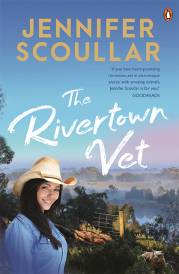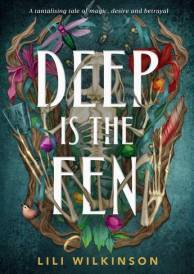Lucy Boynton Sing Street
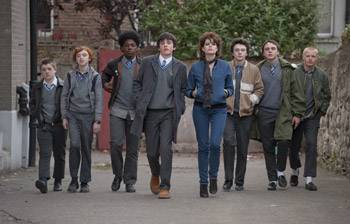
Lucy Boynton Sing Street
Cast: Lucy Boynton, Maria Doyle Kennedy, Aidan Gillen, Jack Reynor, Kelly Thornton, Ferdia Walsh-Peelo
Director: John Carney
Genre: Drama, Music
Running Time: 106 minutes
Synopsis: A boy growing up in Dublin during the 1980s escapes his strained family life by starting a band to impress the mysterious girl he likes.
Sing Street
Release Date: July 14th, 2016
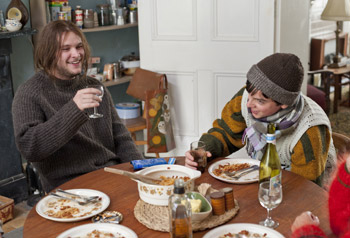 About The Production
About The Production
'I wanted to do something that was personal. I didn't want to just be doing a musical story for the sake of it." - Director John Carney
The origins of Sing Street go back many years to the director's life as a teenager in 1980s Dublin. John Carney experienced growing up in the Irish Capital by moving from private school to an inner city comprehensive. It ultimately became the seed of an idea to create a musical film about this period in his life growing up.
Having worked with producer Anthony Bregman on the New York-set feature film Begin Again starring Kiera Knightley and Mark Ruffalo, the director discussed the idea of building a story around his own experiences growing up in Dublin over a coffee one afternoon. It was in the cutting room that John Carney told Anthony Bregman the story of Sing Street. 'The origins of the project date back probably 20, 30 years, because a lot of the elements of this film have come from John's experience of his childhood," says producer Anthony Bregman. 'He went from a posh school to Synge Street School for a year and went through the same transformation as our lead character - from a very refined educational experience to a much rougher world.
Both a rites of passage story with strong romantic elements and a film built on the musical foundations of 1980s British bands; Sing Street delivers an honest and moving perspective on the perils and wonders of teenage life.
For the producer Anthony Bregman, the idea of a fresh and yet innocent romance blossoming between the two lead characters, was a dynamic he had not seen in filmmaking for long time.
"The relationship between Conor and Raphina is interesting because it doesn't really get consummated in any real way," Anthony Bregman explains. 'She's gorgeous and older, more sophisticated, and is off on her own, living her own life. He is still very much forming as a character. From the very beginning, when he approaches her, it's clear that he's reaching above his grade for her."
Alongside this romance, Carney also focuses on the complexities of marriages breaking down in Ireland during this period. Divorce was not allowed in Ireland at the time. As the parents' relationship breaks down, the impact on the children is profound.
'There are a lot of strains on Conor's parents' marriage; among them that they came from a period of time where you couldn't have sex outside marriage," says Anthony Bregman. 'So the parents got married too soon, for the wrong reason, and then they couldn't separate, because at this point it was very taboo to divorce. The most they could do was separate.
'They're locked in a marriage where they're not happy with each other or with the situation and that filters down to the kids. It creates a toxic atmosphere, and that is what initiates the story."
For Carney the director, the film is also a story of contrasts - the contrast of Ireland versus England, Dublin versus London, and the safety of a private education versus one in the state system. But most importantly for Carney, it was the contrast of a young teenage boy who thinks he has problems until those problems are far outweighed by those of the girl he meets and ultimately falls for.
'It's really a -before and after' story, which is set in 80s Dublin," John Carney explains. 'It was a time of recession and immigration and a time when even the very rich or those who should have had money, didn't have cash, and were forced to think a little bit differently in terms of what clothes they wore, how they expressed themselves through how they looked."
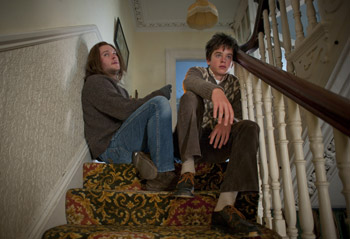 Having directed the Oscar®-winning musical film Once and then Begin Again, both with extensive musical threads throughout, John Carney felt the time was right to make something musical that was even more personal – something solidly autobiographical.
Having directed the Oscar®-winning musical film Once and then Begin Again, both with extensive musical threads throughout, John Carney felt the time was right to make something musical that was even more personal – something solidly autobiographical. 'I didn't want to just be doing a musical story for the sake of it. I wanted to try and find something in my life that I'd be interested in doing and talking about. I wanted it to be something that was genuine and personal."
Producer Anthony Bregman had previously also worked with producer Paul Trijbits on the Stephen Frears film Lay The Favorite, starring Bruce Willis and Catherine Zeta Jones. Paul Trijbits' introduction to Anthony Bregman was through a last minute juggling act to keep Stephen Frears' production alive on the eve of principal photography. Stephen Frears' agent connected the two producers and Trijbits spent a skiing holiday weekend helping to make the film move forward into production.
'I went to New York and somehow we managed to hold that film together. So we became really good buddies through that experience," says Paul Trijbits on his relationship with Anthony Bregman. Anthony Bregman had subsequently grown his company with investment and a slate of films. With an impending production in Ireland, Paul Trijbits was keen to sign up and the two pulled together the project. As an added endorsement, Paul Trijbits' business partner producer Christian Grass had recently seen Begin Again in Toronto and had loved it.
'Christian said it was the most enjoyable, wonderful film that he'd seen. Sing Street then became a co-production between Likely Story, a New York based company, and us in the UK, setting up a joint entity to make the film. Likely Story's producing and financing partners Kevin Frakes at PalmStar Entertainment, and Raj Brinder Singh at Merced Media immediately came on board to fully finance the film."
Trijbits then had to seek out an Irish producer to facilitate the production on the ground.
'We very quickly found Martina Niland who had done Once with John Carney and was ready to take on the producer role," says Paul Trijbits. 'Then Filmnation came on board. We didn't have a script but we had an extended treatment to enable us to put the bulk of the money together. It was essential that we had the Irish Film Board in there, which was also an interesting journey for them. They had supported John Carney before, but now had to make a choice to support him without the script being ready, which they did."
With the finance in place, Carney began to assemble the various elements including music soundtrack, his camera and design teams, and importantly his young cast.
Casting
Producer Anthony Bregman's biggest concern was how the filmmakers would find enough young talent in an industry reliant on -names' to enable a film to survive past its first weekend at the box office.
'When you're hiring a big movie star who's carried movies before, you know whether they have the ability to carry a movie, because they've done it before," says Anthony Bregman. 'But these are kids who have never been in front of a camera and now they're going to be looked at for 90 minutes straight. That's a big burden."
Co-Producer Paul Trijbits agrees - 'You have to believe that there are people out there who are going to be capable of carrying that."
Paul Trijbits has had experience of this before as Executive Producer on Andrea Arnold's Cannes and BAFTA award-winning feature film Fish Tank. 'When Andrea Arnold was looking for the girl to play the lead, that was a nine month journey. If you find people quite quickly and think, -Oh, wow they're amazing,' there's a bit of you that thinks, -Well, if you can find people that good, that quickly, there must be others out there,' and you keep going.
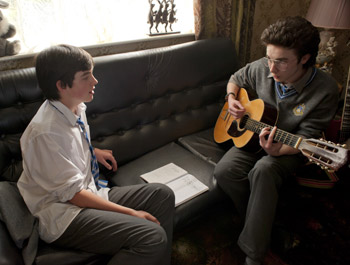 'What's hard is when you have people who are, in this case, relatively young," Paul Trijbits adds. 'Sometimes, there are bits of life experience that aren't present. So then all of a sudden they have to act certain things. You can't just say, -Remember when your heart was broken,' because they might never have had their heart broken."
'What's hard is when you have people who are, in this case, relatively young," Paul Trijbits adds. 'Sometimes, there are bits of life experience that aren't present. So then all of a sudden they have to act certain things. You can't just say, -Remember when your heart was broken,' because they might never have had their heart broken." Unlike the usual casting process, the filmmakers decided to seek out new untapped talent from across Ireland. The team held auditions over a period of six months to look for their lead actor who would play Conor, the lead actress who would play Raphina, and the rest of the young band Conor pulls together at Synge Street School.
Carney, along with Dublin based Casting Director Louise Kiely, set up auditions across Ireland attracting thousands of young hopefuls.
'Casting was interesting because I wanted to get non-actors, firstly," says the director. 'I didn't want them to be like that [Irish Stage School] Billy Barry sort of vibe. I wanted it to be very naturalistic. So we just did a big Open Call and saw everybody from around the country who thought they could play an instrument.
'It's amazing that almost all of the actors in the film are some of the first people we saw. We saw thousands, but you know very early when a kid is amazing. You then start writing the part around the kids that you like and then we started narrowing down the casting, to try her with him and him with her. That's the way we did it."
'John Carney would actually send me pictures, as I was in the U.S. at the time; pictures of crowds of people snaking around blocks," recalls Anthony Bregman of the casting process. 'Every kid with a guitar or a drum kit, coming in. They would do a song and an interview and then they would act out a scene so we could see if they could sing and act. That's how we found Ferdia and everyone in the band."
Ferdia Walsh-Peelo had come from a musical family with a background in opera and Irish folk music. He had been a boy soprano and toured The Magic Flute with the Opera Theatre Company. He was also classically trained on piano.
Echoing the magic of the film's own fairytale sensibility, it was only by sheer luck that he waited in line to audition and be discovered.
'When I got there the queue was so big," Ferdia Walsh-Peelo laughs recalling the process. 'I was with my mum and I said I wanted to go home because I didn't want to stand in that queue for eight hours. I was literally lining up for about five hours. I did the audition and sang a song. I felt it went really well. I then got re-called to a hotel and got down to the last six potential leads, which was amazing. We auditioned with different girls then. We didn't hear from them for a while then, so I went off to Spain with my family on holiday. Half way through the holiday we got a call saying I'd been re-called for a few days time, so I had to book a flight and fly back, which was definitely worth it!"
Carney was delighted with his discovery.
'Ferdia Walsh-Peelo is a very bright young man and the reason that I cast him in the film was that each time he came to an audition he got better," the director explains. 'Each time he left, he'd come back with the information processed that I had given him the time before, which showed me that he had the personality that was right for a film.
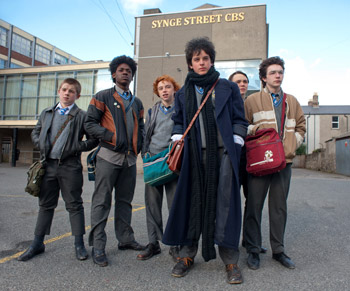 John Carney had not previously worked with a cast of this age group, but he jokes that he has already had enough experience in others ways to give him the confidence to tackle a young band of teenagers.
John Carney had not previously worked with a cast of this age group, but he jokes that he has already had enough experience in others ways to give him the confidence to tackle a young band of teenagers. 'I'd worked with inexperienced actors before," he laughs. 'The first films I made were with my father. I would get him to play roles and try to direct him. I tried to get him to be in a Martin Scorsese style movie when I was young, in the garage. There's no worse actor really I have to tell you. I like working with non-actors. Putting an experienced actor like Mark Ruffalo with Adam Levine who hadn't officially acted before for Begin Again was a really interesting mix - a really dynamic thing to watch on screen. I think people like watching non-actors acting. It's interesting."
John Carney was also able to pull together some of Ireland's biggest names including Aidan Gillen, Maria Doyle Kennedy and rising Hollywood star Jack Reynor.
For Gillen the story trod familiar ground for him, being a similar age and growing up in Dublin during the 1980s. His faith in John Carney's ability to make it more than just a film with music attracted him to play the role of the father, Robert.
'We've seen music films before, but there aren't actually that many of them that work," Gillen suggests. 'John Carney's been in a band and he knows that world. It seemed like there was even more reason for this to work, as it's about what he was doing at that time. I know it's partly autobiographical, but it did resonate with me. I didn't have that direct connection that I'd been in a band. But even the sound of the band that used to practice in the shed near me, and the sound of switching on an amp, the crackle of that electronic noise, actually made my heart race. That kind of sound still has that visceral effect on me."
Production
When a good thing works, Sing Street's director John Carney likes to keep it that way. His Director of Photography Yaron Orbach had been the architect of Carney's New York for Begin Again, transforming the city into a musical backdrop, shooting in the streets with little, if any major support from tracks, lighting or cranes.
Both men had met through a mutual friend, the Irish film director Lance Daly with whom yaron Orbach shot The Good Doctor in Los Angeles. At the time, Yaron Orbach was in a post-production company in Dublin called The Factory doing color corrections on Daly's film. John Carney and he bonded over a few games of Ping-Pong.
'When Begin, Again was about to happen, I had a talk with Lance and he said he'd put in a good word with John Carney," says Yaron Orbach. He'd also had previous experience working with producer Anthony Bregman. 'So when Anthony was involved, there was another kind of 'in." Between Lance and Anthony, I got to meet John in New York and here we are."
'It's funny working with Yaron," says Carney. 'He's a Jewish guy from Israel originally, who lives in New York. He boned up on about 50 different Irish movies when we were in prep over those few months. But I was really glad to shoot it with a cameraman who wasn't from Ireland. He brought a great eye to Begin Again. That movie was set in New York. But he was also very interested in the light in Dublin and the way the light works here."
Inspired by the Technicolor look of the TV programs he watched as a boy, John Carney was drawn to the idea of mixing the drab universe of 80s recession-era Ireland and what the director describes as 'this colorful, amazing world" of pop videos.
'I lived through watching Top of the Pops and imagining that there was this great world of Duran Duran videos," John Carney says. 'That's what I thought London was like and I couldn't wait to get there. Not only was it the world in which you got 10 Marlboro instead of 20 in a pack, it was just incredible haircuts and sexual liberation and freedom and we were still back here arresting people for putting condom machines in colleges. It was crazy.
'When you lived in Dublin, you couldn't get your hands on a camera to save your life, or a costume or a look. We found that that was the way we were going to shoot the movie, do a sort of -before and after' thing. So you get the greyness of Dublin next to the Technicolor videos that they shoot, or what's in Conor's head."
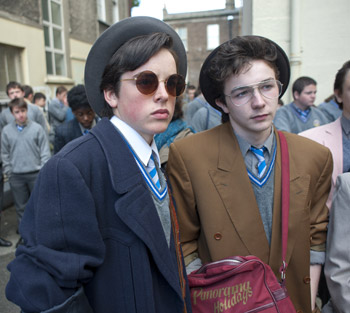 Keeping the same shooting style as Begin Again, Yaron Orbach stripped down the camera.
Keeping the same shooting style as Begin Again, Yaron Orbach stripped down the camera. 'We wanted to give it a slightly different, more filmic look, but keeping the spirit of Once. So we kept the handheld, no big lighting, no dollies, no SteadyCam, it was all handheld, with that kind of free improvisation," Orbach explains.
Extending the unique approach both the director and Orbach had to shooting, Carney would call in the cast to feel their way around the scene and the set with Orbach lining up the first wide shot and then build the scene from there without an official shot list.
'John Carney doesn't like to shot list," Yaron Orbach admits. 'We came onto the set and there would be a mini line-reading/rehearsal. The actors would see where they wanted to put themselves and I would have a camera and put a wide lens on my shoulder. We'd find the master and we go from there. We found the scene very quickly that way.
'Because of John Carney's style, which is all-inclusive and open to things that happen, there's a lot of room for spontaneity with kids. It has been a bit challenging here and there. There were no positioning marks on the floor; we let them go wherever they wanted."
'I like giving actors room to improvise a little bit and move around the script," admits the director. 'Sometimes things that kids say when they're trying to remember the line that you wrote will often land on something way funnier than something that I could write. So I would often encourage the kids in this film, if they've forgotten their line, to not worry and just keep going and make some stuff up. It's been fun and it is easier to do when it's your own script."
For the Production Designer Alan MacDonald (whose previous work on Love is the Devil, The Queen and Philomena displayed his skill at period environments) tackling Dublin of the 1980s was a wonderful challenge.
Alan MacDonald began by defining the moment in which we find ourselves – in this case, the early 1980s inner city Dublin. From there, he began slotting in each character to their background, creating a tableau to reflect their personalities, economic status, and most importantly, offering a back story to them as the film's timeline only spans a few months.
'You psychologically have to analyse each individual character and the world they're coming from and the world they're living in," says Alan MacDonald. 'I always see sets as psychological portraits of people's socio-economic status or level, but also it's a kind of emotional tone in terms of how the film progresses and how the narrative progresses."
For the family household, Alan MacDonald understood that we meet them at a moment when they have fallen on hard times. Any wealth that might previously have made the house an affluent environment is crumbling.
Alan MacDonald explains - 'The world of Conor and his parents is the world of a family collapsing. It's quite depressing. They've run out of money. They obviously had ambition and dreams that have collapsed around them. That becomes the basis for the design of the house: it's in decay." The production chose to seek out locations in and around Dublin rather than look to do extensive builds of interiors in studios. In particular, the buildings of the Synge Street School, in the eighth district of the city spanning the Liffey, which still operates as a state-run Christian Brothers School, is not much changed since Carney's days there.
'I would say 50 percent of my job is getting the locations right," says Alan MacDonald. 'If they tell a truth, to me as a designer and as a writer-director, you're half way there. I had a great Locations Manager, Eoin Holohan, with whom I worked. I really pushed him because I knew that there would be locations that were remnants of the 80s in this town.
'For example, Eamon's house is a good one. As a basis, it had the remnants in a few rooms of just insane carpets and wallpapers, which immediately gives you a foundation on which to build."
The Music
Writer/director John Carney wanted to find a songwriter early on in the development process to enable him to bring an authentic but accessible 80s sensibility to the songs he wanted the band to play. One such songwriter John Carney had considered – Gary Clark - had recently moved back to his hometown of Dundee in Scotland from Los Angeles.
Clark is possibly best known for his hit single Mary's Prayer that he wrote for his band Danny Wilson in 1987. The song was released three times in the UK between 1988 and 1989 before reaching no. 3 in the UK charts. But in Ireland, the song had already become a huge hit, reaching No. 5 in the charts on its first release.
No stranger to working with musicians to devise a soundtrack, John Carney had previously worked with Glen Hansard who starred in John Carney's directorial debut Once and also wrote and performed the songs throughout the film. One of the film's songs, Falling Slowly, won an Oscar® for Best Original Song in 2007.
For Begin Again John Carney had employed New Radicals frontman Gregg Alexander to create the soundscape that formed the basis of Kiera Knightley's character's song book.
'I wanted to explore some different options on this film," John Carney says. 'It's set in the 80s, so I wanted to get somebody who had actually written music during the 80s. I loved Mary's Prayer. So I found Gary Clark. I rang him up out of the blue and said I made this film called Once. He had seen and really liked it. I said that Mary's Prayer and his album [Meet Danny Wilson – 1987] changed my life. I listened to it with my brother when I was 14 in school when I should have been doing my work. I said, -What do you think about writing some songs, and I have some half-written songs which you could write lyrics for?'
'He got on a plane and came over. He is a brilliant songwriter and with a very hooky, 80s style - very catchy songs. He wrote about five or six songs."
John Carney and Gary Clark worked for a solid month before filming, recording the tracks with a studio band comprised of some of Ireland's top session musicians. Ironically, because the band in the film has to begin learning to play as a band without the competence of a well-rehearsed ensemble, the musicians were encouraged to play badly.
'They were all told that they had to play down so that it felt realistically like a bunch of kids who weren't Ireland's greatest studio musicians, actually playing!" laughs producer Anthony Bregman. 'Especially the songs that happen earlier in the script. They do a cover of Rio by Duran Duran and the whole point of the recording of the cover is that it's bad. We were sitting in the studio and John Carney was saying, -No, it's too good. Mess it up. Go faster. Go out of tune. Go out of sync.' It was really trying to bring these great musicians down to the level of believability for kids who don't know how to play."
As the film's protagonist Gary Conor begins to experiment with different styles of 80s music, the songwriting and musicianship had to reflect his progress.
'The band goes through different phases," Anthony Bregman adds. 'They do a Duran Duran type song, then they do a Hall & Oates, they do a Cure, and an Elvis Costello type song. Each song is based on these different styles of songwriting and of singing from the 80s. It's really fun to recognise a song that you haven't heard before. You get what the style is."
John Carney's love of music is reflected explicitly in his biography as a filmmaker. Co-Producer Paul Trijbits recognised the value of this early on the film's development process, noticing the relentless passion John Carney brought to every facet of the film's soundtrack.
'John Carney's absolute skill is to tell stories using music. When you look at things that he's done that we all love, that's when he's in his element. He knows how to do it. He had a great time being part of recording an album and effectively discovering a real young band. Finding Ferdia to become the lead singer of a band to the people around him, the musicians who were part of it, made it all a really joyous experience for John and us. We were recording an album that we were laying down to sit alongside the story. But equally, it had to serve the story, which I think it cleverly does."
When asked which bands and songwriters influenced him as the story came together, John Carney is quick to respond and comprehensive in his knowledge.
'God, Frankie Goes To Hollywood was one of my favourite bands. Somebody asked me what was my guilty pleasure, and it has to be Level 42. I was a bass player so I was big into Level 42. I do sometimes pull a Level 42 CD down off the shelf and my girlfriend leaves the room, but I love them. I was listening to synth pop and funk and what everybody else was listening to as well: Joy Division, The Cure and loads of different stuff. Lots of American music as well; a list too long to mention."
For John Carney's Director of Photography Yaron Orbach, the trick was how to incorporate the musical elements into the narrative and shoot it seamlessly so that the audience was saved the awkward jump from dialogue to singing and music.
'What's wonderful about handheld and about the loose approach is that it's kind of rhythmic," say Yaron Orbach. 'Even when I'm just standing there, I can lean in and I can lean out. I think that gives a certain tempo to it, so when we're capturing singing, I think the handheld has a naturally good marriage because it feels a bit more alive than if you're doing very static dolly or crane shots." Along with the session band was the integration of the film's lead actor Ferdia Walsh-Peelo who was thrust into center stage to make the vocals come alive.
'The studio was pretty intense," Walsh-Peelo admits. 'For about a month before that, I worked on vocals once a week because it was going to be long sessions in the studio where I'd be singing all day long. I learnt a lot from that."
For other members of the cast, it was an opportunity to reminisce. For actor Aidan Gillen it was an opportunity to reflect on some of his earlier encounters with 80s music as a teenager. 'I remember blagging my way into some pretty good stuff - Echo And The Bunnymen, The Smiths and U2," Gillen recalls of his years living in Dublin. 'There had been these bands coming out of Dublin. There was such a thing as an Irish rock star, like Van Morrison, Phil Lynott or Rory Gallagher, but they were looking back at blues stuff. With the likes of U2, it was something that was happening that was new. It was part of a new wave. It did feel exciting and it was happening in Dublin."
Actor Jack Reynor is a child of the 90s but his music tastes were influenced very much by his own mother.
'I listened predominantly to music from the 70s and 80s growing up," he says. 'I would sit on set all day blaring out Steely Dan. My mother was born in 1970 and had grown up in the 80s and when I was a child I knew all of her friends and the kind of culture that she had. It does resonate with me in a lot of ways and I'm definitely able to relate to the cultural context of the film.
'I was into music when I was 14. I liked The Beatles and The Rolling Stones and Guns n Roses. My musical taste has developed and matured since then. I was in a couple of bands when I was growing up and I loved it. I played guitar, a little bit of piano. I don't do it any more, I miss it." For the younger members of the cast, it was an education in historical pop music. Carney would show the boys videos from the 80s to inform them of the way in which the bands moved on stage and on screen.
For the band's young keyboard player Percy Chamburuka who plays Ngig, it was something very new. 'Yeah, when I got the recall that's when John showed me some dance videos from the 80s and keyboard players and the way they used to dress. Also the whole music history of it - I had no clue about what type of music they were listening to and what style it was. So I've learned quite a bit about the 80s."
For Lucy Boynton, who plays the film's female lead, the musical education became a running joke between her and her director.
'It was really awkward because John kept referencing these really amazing films and songs and saying, -You know this?' And I'd say, -No,' and he'd say, -For God's sake Lucy, where have you been living? What's wrong with you?' I'd say, -I'm so sorry, I wasn't born in the 80s!'"
The Vibe Of The 80s
Dublin in the 1980s was wracked by an aggressive downward socio-economic trend. Following the 1979 energy crisis, one of the then Prime Minister of Ireland Charles Haughey's first functions was to address the nation about the worsening state of the country's economy. With the government borrowing becoming a heavy burden on Ireland's economic survival, many found themselves unemployed and struggling to maintain the quality of life they are previously been used to living.
However, director John Carney was keen to avoid the pitfalls of making a story about the economic downturn and effects on his surviving family. Instead, he concentrated on the contrasts that this moment in history presented to teenagers and their parents.
Divorce in Ireland up to and during the early 1980s was still prohibited and had been enforced by both the dominant Catholic Church and the Anglican Church of Ireland. An amendment to the Constitutional Bill had been proposed and rejected outright in 1986. The ban on divorce in Ireland was only lifted in 1996.
Carney wanted to explore the dynamic of a family living under this law and how it affected the children, ultimately the products of a dissolving marriage.
'I didn't want to do anything about Dublin politically, about the dark days of Ireland that we were living in, in the late 70s and 80s. But it's more about a family falling apart. There are certainly no politics in this film, directly speaking," he says. 'There are just cultural politics to a degree. But really it's about a family in trouble. The film is about a kid learning that, given the environment in which he's growing up, he's got to go off and create his own family. That his nuclear family into which he was born is not going to solve the problems of his heart and his head.
'There are questions about unemployment and immigration in the film, but it's not about that. It's more about the idea of Ireland as an island. You can potentially get trapped in Ireland. It's such a small country and it's such a small population in a sense. You can think that you're doing very well, but you're not really doing that well from an international perspective. The film is in a sense a little bit about that; the kid realises he has to go away and have some experiences elsewhere, apart from just living in Ireland."
'It was certainly more uncommon," says actor Aidan Gillen on the theme of divorce. 'At that time there was a lot more people staying together because they felt they had to. It's almost the norm not to, now. At that time there was stuff that kids just didn't talk to their parents about. It was an era when parents weren't trying to be best friends with their kids. They really were from another era, another age and just didn't understand you. I do think however that kids now are probably more distant from their parents. They feel like they're closer and they can talk about anything, but they're lost in cyber space pretty much all the time. It's quite hard to reach your kids, even though they're loaded down with communication devices."
The family dynamic was an element of the storyline to which the more mature actors could easily relate. For Jack Reynor who plays older brother Brendan, it was a scenario that would be recognisable to many Irish families who lived through the 80s.
'Because we've all grown up watching The Late Show on Friday nights with our families when we were kids, we understand the dynamics of an Irish family at the dinner table. It all came quite naturally to us. We knew where the cues were to pick up from one another. Aidan [Gillen] and Maria [Doyle Kennedy] are really great, veteran actors who have this kind of thing down. They were excellent in those scenes. Then you've got Kelly [Thornton who plays Conor's sister Ann] and Ferdia [Walsh-Peelo], two very good young actors in their own right. They were really good at taking on those scenes and making them feel authentic.
Producer Martina Niland notes that family lives, the contrasts between Ireland and England, and in particular Dublin and London at that time were stark. 'John's was an Ireland that was this tough, grey, quite depressing place at the time. It didn't seem like fertile ground for the creative industries, whereas, London by contrast, seemed like a metropolis and seemed so colorful. The film explores that perception I suppose, through Conor and the escapism, through the TV in the corner, which had Top of The Pops, Duran Duran and all that kind of stuff going on."
For costume Designer Tiziana Corvisieri, Sing Street offered a very accurate picture of life in that decade.
'For me, Sing Street is a very authentic representation of Dublin in the early 80s. I was here then and I was a 16-year-old in the early 80s. To me, it really does represent what was going on here. Across the water in the UK, everything seemed to have been going on. While here, we were always looking across the water to see what was going on in the world."
Rather than making the film feel as though it was made in the 1980s as other retrospective films have done to heighten the sense of place and time, Carney was keen to transport the audience there as though they were actually living it now - the colors, textures and sentiments being immediate and yet historical.
'John Carney wanted to make a point when we spoke, that this is a movie set in the 80s, but it's not an 80s movie," says producer Anthony Bregman. 'Meaning that he's not doing a homage to 80s movies. He's saying that he's making it seem as though we're there, that we're living it. That's an interesting distinction. You look at a 1980s movie now and you have to allow yourself a certain amount of 80s Hollywood artifice that wouldn't work in a movie today. So, even while the movie is taking place in the 80s, it's not being told in a way that would make us roll our eyes, it has to be something that we would understand. John has a style of making movies that is really consistent and this fits squarely into it."
Standing on set as someone who was raised in the 1980s gave the crew an eerie sense of déjà vu. Costume Designer Tiziana Corvisieri's extraordinarily well-sourced costumes from the period, Barbara Conway's and Sandra Kelly's hair and make up work, and Alan MacDonald's pin-point accurate art direction meant that no stone was left unturned in maintaining the true sense of -now' that Carney insisted on.
Bregman felt it particularly during the school gig scenes - 'It's quite trippy for those of us who grew up in the 80s to look out on that crowd. It takes you back. You remember actually being there, in that crowd, with that over made-up, over-teased hair. You get to a certain age where a period film can actually be a part of your life that you remember."
For Martina Niland it was the detail that made the whole environment convincing.
'It was more about seeing the washing up liquid we used in 1984 or 1985," she points out. 'Was it the little baby running across the tall Fairy bottles, that were white? It was about getting all of the utensils and things right and having people look at the film and go, -Do you remember that?' That was really the key in John's instruction to the art directing team. For a certain age group, it's such a memorable decade I think, looks-wise, music-wise and costume-wise. You need to try and get that right so that they can enjoy the movie all the more."
'I didn't want to do big crane shots of big period detail. I'm not really that type of filmmaker. The devil is in the detail of these things. It's the little digital watch that flashes you back to the period, or it's the song on the radio or the hairstyle or the clothes, more than the big master shot," says John Carney. 'So we didn't go out into the streets and film Dublin that much. It was more about the close detail, about the clothes and the vibe of the 80s rather than what Grafton Street looked like in the 80s."
The film is peppered with 80s video moments as the band experiment shooting their own pop videos in the back alleys of Dublin and further afield in Dún Laoghaire. To incorporate these into the narrative of the film, John Carney and his Director of Photography Yaron Orbach looked closely at numerous 80s videos, analyzing their structure, design and editing.
'John Carney sent me a bunch of 80s videos, from Police to Madonna, everyone who was doing videos back then," says Yaron Orbach. 'We'd look at the style - Duran Duran was an important one - we'd look at the wackiness of it. They were just starting with the whole music video thing and getting cinematic, getting film cameras and film directors to shoot these music videos - it was a big outlet. It was interesting looking at them as a reference.
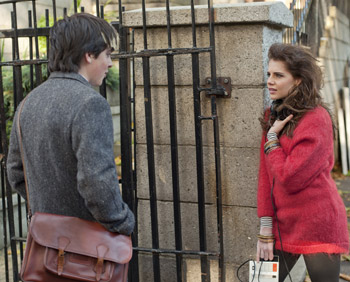 'At the beginning it was doing this more as a set piece and then, as we evolved, it seemed that because they're kids, they're kind of trying out and learning themselves. They have a little video camera and they're experimenting. So the first video was very shaky and not in focus, like a kid would do it. Then the second music video they're getting a bit better, so it's a bit more precise. The third music video - we decided to go a bit more into their imagination, so we're shooting that on film. It's departing a bit from the language, but it will probably be the most polished of them all and the most referenced to 80s videos.
'At the beginning it was doing this more as a set piece and then, as we evolved, it seemed that because they're kids, they're kind of trying out and learning themselves. They have a little video camera and they're experimenting. So the first video was very shaky and not in focus, like a kid would do it. Then the second music video they're getting a bit better, so it's a bit more precise. The third music video - we decided to go a bit more into their imagination, so we're shooting that on film. It's departing a bit from the language, but it will probably be the most polished of them all and the most referenced to 80s videos. 'We shot the music video sequences on mini DV. We tested super VHS. It looks so good and bad at the same time. So we said, -OK, we want to have that spirit, but let's give ourselves just a bit more quality to play with.' So, mini DV felt like a good starting point. With two cameras, mini DV, no lights, nothing. The producers were like, -What are we doing?'"
For Production Designer Alan MacDonald it was all too familiar. 'When I was Conor's age, 13/14, I was obsessed with David Bowie. Of course that had a huge transformative effect on my life. It informed how I started to dress, how I started to wear makeup or dye my hair. That's what Conor does in this film. It's the same thing. He looks for these keys to discover who he is and what his identity should be. Music was the only real catalyst for me in developing an outward persona in terms of style, clothes.
'I think that's one of the things that appealed to me about the film, is that it was an important time in my life. I was involved in designing and making a lot of pop videos at that time and I am obsessed with music, still. I think the music element is important in terms of the narrative because that's the moment, often, when children grow into teenagers. They suddenly start to get interested in something that informs them, not just sonically, but also aesthetically. They start to notice clothes, hairstyles, boys notice girls, girls notice boys. They notice makeup. They start to dress better. I think the music thing was interesting to me but the idea of becoming a teenager was even more interesting."
During the early 1980s, with fewer references from which to draw inspiration, MacDonald believes it was easier to make a mark in fashion, music and art.
'You really had to research. You'd watch Top of the Pops once a week and that would give you keys. You'd get NME or Sounds or Melody Maker or whatever and they would be keys. There was no youth culture magazines, no Internet, no digital blandness…"
The sense of innovation was something Costume Designer Tiziana Corviersi brought to the project. 'There was no money in the 80s, so you couldn't buy new clothes. Even if you did have money and you wanted to buy new clothes and trendy clothes; you couldn't get them in Dublin. I think young people were always going back to charity shops, second hand shops and a lot of the time they were altering clothes to make them look like contemporary and funky clothes. But there was a lot of hand-me-down stuff from the 70s. There was raiding of siblings' and parents' wardrobes, definitely it was a mixing pot of ideas."
Dublin As A Location
The production shot the majority of days on location in and around Dublin with only one significant built set being Brendan's room. The shoot benefitted from Dublin's architecture not having changed too dramatically from the 1980s and where it had, the art department was able to retro-fit some design work to bring it back to the period.
For the director John Carney, the film was not so much about promoting a large scale look at what Dublin might have felt like during this decade, but more a sense of how it felt to be there in people's homes, schools and back streets.
There are pockets of Dublin that haven't changed that much," says producer Martina Niland. 'Apart from trying to navigate the odd satellite dish here and there, and things that just weren't around, there are ways of being smart about it. We didn't have huge resources to throw at it so we picked the right streets that had the look."
Producer Anthony Bregman agrees. 'These buildings have been here since the 80s, every place, every shop, was basically there since the 80s. They've changed a little bit and we've changed it back. One of the big challenges on Begin Again was that we were shooting a lot on the streets of New York and we had famous people in the movie, so wherever we were, it created these huge crowds of on-lookers snapping with their phones. Because Dublin isn't a paparazzi culture and these kids are not paparazzi magnets - at least not yet - there weren't so many distractions. They could just get into the scene without us having to block out the lenses and the crowds."
The crew shot extensively in the high walled yards of Synge Street School using the geography of the exteriors to highlight the inner city feel of the school. Synge Street School itself has changed very little since the 80s.
When filming on the streets of Dublin the production had noted in referring to old photography of Dublin from the 80s that, rather than fill the streets with period correct cars, they were able to leave them fairly empty. 'Often with movies like this there's a tendency for when you do street scenes, to put loads of cars in and think that'll tell the story," says Production Designer Alan MacDonald. 'But no, you look at pictures of Dublin in the 80s and there are hardly any cars on the street."
The Characters
Sing Street follows 15-year-old schoolboy Conor as he moves from a private school education into an inner city school environment. At the same time, he is dealing with the breakdown of his parents' marriage. Though lead actor Ferdia Walsh-Peelo is of the similar age and had also experienced the concept of changing schools, this is where the similarities end.
Director John Carney and his young lead worked closely together to build college journey from what Ferdia Walsh-Peelo describes as a loser with low self-esteem to someone with confidence. 'I had an experience of changing schools as well, but I wanted to do it, it was my decision, so it was a different kind of thing," explains Ferdia Walsh-Peelo. 'I think Conor is similar to me with the whole music thing and what music means to him. The things I don't relate to as much are probably his parents who are not as caring. They're a bit weird."
Working with John Carney was a highly informative experience for the young actor. __Being both a writer and director, John Carney was able to restructure scenes organically with his young cast, allowing the opportunity to improvise and to feel their way through the role. Ultimately for John Carney, this offered him a much truer performance. 'It's really interesting, because when we started out we'd be thinking of a scene completely differently to how he [Carney] wanted it, and then we'd have to get into our heads what he meant," says Ferdia Walsh-Peelo. 'He didn't give us the exact way he wanted us to say it. He wanted that to come naturally."
Actress Lucy Boynton came to the project with slightly more experience than the others. She had already worked in film and TV with credits including Miss Potter opposite Rene Zellweger and Ewan McGregor, and The Borgias opposite Jeremy Irons.
The role of Raphina offered Boynton a chance to play a complex young girl, old before her age, who becomes the focus of John Conor's romantic odyssey.
On Raphina, Boynton says - 'She's been through a lot of stuff that thankfully most people her age haven't been through. Her response to that is feeling like she's older, so acting a lot older than her actual age. You see that throughout most of the film, but there are some bits where you see her at her most vulnerable. You see that when she's without her hair and makeup, which she uses as a defense.
'Raphina is this pivotal point in John Conor's growing up. She opens his eyes to life beyond school. He is also so innocent and willing to understand her and know her and be patient with her, that that really surprises her."
Walsh-Peelo and Boynton bonded over the process of finding their way through the characters' relationship. With Boynton already a seasoned pro in front of the camera, Ferdia Walsh-Peelo constantly took mental notes on performance. But Boynton found the process equally informative.
'Me watching him is more interesting than him watching me because you're looking at somebody who probably hasn't done much acting before," Boynton says. 'It's interesting watching somebody relatively new to the game finding their way. I always have enjoyed watching people who aren't set in their ways and who aren't relying on their old tricks and the stuff they've done before that works for them. It's interesting watching somebody do something that's hard and being put through the mill!"
For actor Aidan Gillen, his character had a number of familiar references. 'Robert is an architect who works at home," Aidan Gillen explains. 'Funnily enough, my father was an architect who worked at home. I was the same age in the era this film is set, as Conor is. My father wore polo necks and he looked just like this, and he drank whisky occasionally too.
'I myself started acting when I was about 14 and going to see bands at that age. Those two things are probably two of the main passions in my life, still - acting in films and listening to music a lot. It's really nice to be acting in a film where the main characters are teenagers, and looking at them doing stuff for the first time ever, maybe even acting for the first time. They're in situations, even in a film or make-believe setting, that they're in for the first time in their lives. It's exciting. 'The things you do when you're 13 and 14, that you get into - they often do stay with you for the rest of your life. Definitely my own character and personality was really formulated around then. It was at that age that, like the characters here, that you're breaking away from your family, finding out who you are. You may or may not stick with that, with what you're discovering in those years, for the rest of your life. In my case, I think I did."
For actor Jack Reynor, his character Brendan gave him the chance to channel his inner Pink Floyd fandom.
'He's a complete stoner and sits up in his room all day, every day, listening to LPs and not doing much," Jack Reynor says of his character. 'I think it's a result of the relationship that he's had with his parents and the things he wanted to do; the restrictions they've put on him have pushed him a bit further down this path. In a way, he acts as this sage-like character for Conor and he introduces him to all of this music and culture. He tries to help him to define his ideas and his opinions about his relationships and the girls. There's an element of Brendan living vicariously through his younger brother too.
'John Carney didn't give me any notes. It's a little semi-autobiographical for John Carney . I think my character was representative of somebody in his family. I've known him for a long, long time. We've always had a good rapport. He came and spoke to me about the role and just gave me the history of his family and his life and some of the relationships that he'd had.
'I could really relate to the character because I had similar people in my life and I knew what I wanted to do with it after that. I think John Carney was happy enough to trust me and let me go for it. If there was something specific that he wanted, he'd look for that and he'd find it. But outside of that he trusted my vision for the character and I think we were on the same page."
On his look, Jack Reynor comments on the long hair he sports – a departure from the cropped look he's worn in many of his other roles. 'I wanted my hair long to look as much like Dave Gilmour as I possibly could. I just kept hammering John Carney until he eventually let it go. That was pretty much it. That was how the hair thing went.
'I knew that he needed to look a bit disheveled and a bit introverted. We wanted him to be a bit scraggly and unshaven, just to give the sense that he'd been up there for a while and he was struggling to get through this part of his life. I think that really plays in the film. I think the character looks the part."
'The Best Universal Stories Are Very Specific"
Producer Anthony Bregman believes what makes Sing Street such an inviting proposition not only for those who joined the team to make it, but also for those audiences who will engage with it internationally is that it has a universal resonance.
'The best universal stories are very specific," he says. 'I think Sing Street is very specific in that way. All of my favorite stories happen in a community, in very specific circumstances, but they're universal. One of the great aspects of being able to identify with a Chinese story, or French story, or Greek story, is that even though you live a life nothing like them, you actually share an enormous amount in common. That's what's going on here."
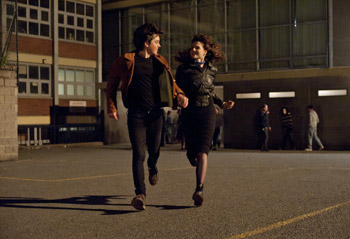 The key to his initial engagement with the story for Co-Producer Paul Trijbits was the -What if...?' question. 'I think it's aspirational, that always helps. You can ask yourself the question, -What if? What if it was me that was taken out of a secure and familiar school and dumped in, what was certainly in the 1980s, one of the most notorious inner city schools? What would I do? How would I survive? How would I get out?' That's a very classic form of storytelling that will appeal today to a very wide audience."
The key to his initial engagement with the story for Co-Producer Paul Trijbits was the -What if...?' question. 'I think it's aspirational, that always helps. You can ask yourself the question, -What if? What if it was me that was taken out of a secure and familiar school and dumped in, what was certainly in the 1980s, one of the most notorious inner city schools? What would I do? How would I survive? How would I get out?' That's a very classic form of storytelling that will appeal today to a very wide audience." Director John Carney brings the appeal for him back to the difference of family life in the 1980s compared to the parent/child dynamic of contemporary families.
'There's a lot about marriage and separation in the film and the question of whether kids prefer their parents to stick together or to separate," he says. 'You'd hear about a family where the parents had officially split up. There would be whisperings about a family in trouble, but nobody was actually breaking apart. They couldn't afford to and the church didn't allow it.
'My lead character Conor hears that his parents might be splitting up, and the way he deals with it is to think about American TV shows in which you'd see couples splitting up and it's all cool and the kids are fine. I remember that I'd go into people's homes and you'd realise there was something wrong in the house; these people weren't happy, but they'd stayed there to save face or save the wallet. In Sing Street there's talk that the mother is having this affair and the kids are trying to process all of that information, in Ireland, in the 80s, which seems to me like a very interesting story to be telling."
Sing Street
Release Date: July 14th, 2016
Have You Seen This?
MORE




